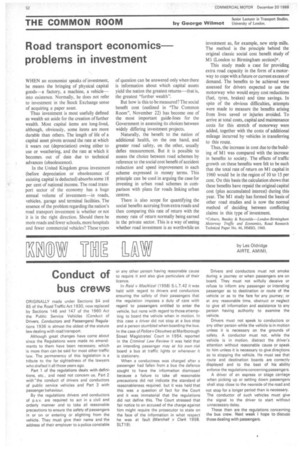Road transport economics problems in investment
Page 54

If you've noticed an error in this article please click here to report it so we can fix it.
by George Wilmot University of London.
WHEN an economist speaks of investment, he means the bringing of physical capital goods—a factory, a machine, a vehicle— into existence. Normally, he does not refer to investment in the Stock Exchange sense of acquiring a paper asset.
Thus investment is most usefully defined as wealth set aside for the creation of further wealth. Most capital items are long-lived, although, obviously, some items are more durable than others. The length of life of a capital asset pivots around the rate at which it wears out (depreciation) owing either to use or weathering, and the rate at which it becomes out of date due to technical advances (obsolescence).
In the United Kingdom gross investment (before depreciation or obsolescence of existing capital is deducted) absorbs some 18 per cent of national income. The road transport sector of the economy has a huge annual volume of investment—in roads, vehicles, garage and terminal facilities. The essence of the problem regarding the nation's road transport investment is whether or not it is in the right direction. Should there be mote roads and fewer schools, more hospitals and fewer commercial vehicles? These types of question can be answered only when there is information about which capital assets yield the nation the greatest returns—that is, the greatest "further wealth".
But how is this to be measured? The social benefit cost (outlined in "The Common Room", November 22) has become one of the most important guide-lines for the Government in assessing its choices between widely differing investment projects.
Naturally, the benefit to the nation of additional health, 'on the one hand, and greater road safety, on the other, usually defies measurement. But it is possible to assess the choice between road schemes by reference to the social cost benefit of accident reduction and speed improvement in each scheme expressed in money terms. This principle can be used in arguing the case for investing in urban road schemes in comparison with plans for roads linking urban centres.
There is also scope for quantifying the social benefits accruing from extra roads and then comparing this rate of return with the money rate of return normally being earned in the private sector. This is a way of seeing whether road investment is as worthwhile an
investment as, for example, new strip mills. The method is the principle behind the original classic social cost benefit study of M1 (London to Birmingham section)*.
This study made a case for providing extra road capacity in the form of a motorway to cope with a future or current excess of demand. The benefits to be achieved were assessed for drivers expected to use the motorway who would enjoy cost reductions (fuel, tyres, brakes) and time savings. In spite of the obvious difficulties, attempts were made to measure the benefits arising from lives saved or injuries avoided. To arrive at total costs, capital and maintenance costs for this stretch of motorway were added, together with the costs of additional mileage incurred by vehicles in transferring to this route.
Thus, the increase in cost due to the building of M1 was compared with the increase in benefits to society. The effects of traffic growth on these benefits were felt to be such that the total rate of return on M1 capital in 1960 would be in the region of 10 to 15 per cent. On this basis the calculation shows that these benefits have repaid the original capital cost (plus accumulated interest) during this year. The M1 study has formed the basis of other road studies and is now the normal method of deciding between conflicting claims in this type of investment.
*Coburn, Beesley & Reynolds—London-Birmingham Motorway Traffic and Economics, Road Research Technical Paper No. 46, HMSO, 1960.


























































































